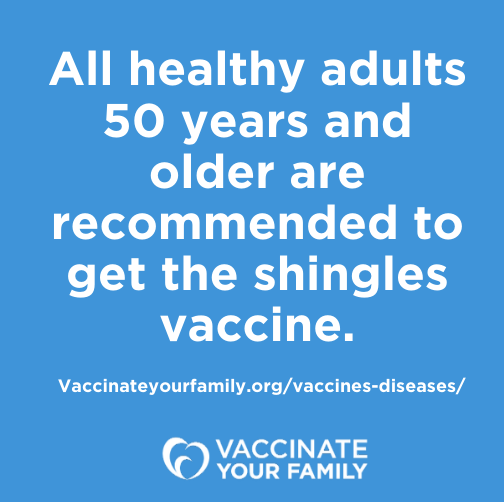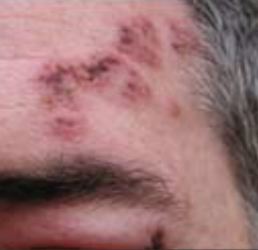Shingles
What is shingles?
Shingles, also known as herpes zoster, is a painful skin rash caused by the varicella zoster virus—the same virus that causes chickenpox. After recovering from chickenpox, the virus remains dormant in the nerve roots of the body. In some people, it stays inactive but in many others, the virus can reactivate later in life, leading to shingles.
According to the CDC, about 1 in 3 people in the U.S. will develop shingles, with approximately 1 million new cases reported each year. Most individuals will experience shingles only once, but it is possible to have it more than once.
On this page, you can explore whether shingles spreads, who is at risk, what the symptoms are, the complications, treatments, and how to prevent shingles.
new cases of shingles are reported each year in the U.S.
Can shingles spread to others?
Shingles cannot be passed from one person to another, but the varicella-zoster virus can spread from a person infected with shingles to cause chickenpox in someone who never had chickenpox or the chickenpox vaccine. The varicella-zoster virus can spread to others through:
- Direct contact with the fluid from shingles rash blisters
- Breathing in virus particles that come from the rash blisters
A person with shingles is not contagious before the blisters appear or after they have crusted over.

Anyone who has had chickenpox is at risk for developing shingles. However, the risk increases with age, and it is most common in people aged 60 and older. While less common, shingles can also occur in children.
Shingles is more likely to occur in individuals with weakened immune systems. This can be due to aging, conditions like HIV or cancer, cancer treatments, excessive sun exposure, or medications taken after an organ transplant. Even everyday stress or catching a cold can lower your immune defenses, increasing the likelihood of shingles.
Cover the rash. The risk of spreading the virus is low as long as the rash is covered.
What are the symptoms of shingles?
Shingles symptoms typically begin as pain, itching, or tingling in the area where the rash will later appear. This may occur anywhere from 1 to 5 days before the rash shows up.
Once the rash develops, it usually forms a single stripe along one side of the body, or in some cases, on one side of the face. The rash consists of fluid-filled blisters that generally scab over within 7 to 10 days. The rash typically clears up within 2 to 4 weeks.
In rare cases, especially among individuals with weakened immune systems, the rash can be more widespread and resemble a chickenpox rash. For visual reference, you can find photos of shingles cases on the CDC website.
Additional symptoms may include fever, headache, chills, tiredness, and an upset stomach.


Are there any complications that can occur from shingles?
The most common complication of shingles is post-herpetic neuralgia (PHN), a condition where severe pain persists in the areas where the shingles rash occurred, even after the rash has healed (typically after 90 days or more). While the pain from PHN usually improves within weeks or months, for some people, it can last for years and significantly impact daily life. The risk of developing PHN increases with age, and the pain tends to be more severe in older individuals. PHN is rare in people under 40 years old.
In addition to PHN, shingles can lead to serious complications, particularly involving the eyes. In rare cases, shingles may also cause pneumonia, hearing loss, blindness, brain inflammation, or even death. Adults face a higher risk of hospitalization and death from chickenpox complications.
Shingles on the face can affect the eye and cause vision loss.
Is shingles treatable?
Several antiviral medicines are available to treat shingles and can help shorten the duration of the rash and reduce pain. For the best results, antiviral medications should be started as soon as possible after the shingles rash appears. If you suspect you have shingles, it’s important to contact your healthcare provider right away to discuss treatment options.
Unfortunately, there is no cure for PHN but it is treatable.
How do you prevent shingles?
The best way to protect yourself from shingles and its complications is to receive the shingles vaccine. The shingles vaccine is 97% effective in preventing shingles in people ages 50–69 and 91% effective in people aged 70 and older.
The CDC recommends 2 doses of the shingles vaccine for those:
- 50 years and older
- 19 years and older who have weakened immune systems
For the best protection, you need both recommended doses of the shingles vaccine. The second dose should be given 2–6 months after the first dose.
Even after having shingles, vaccination is recommended to lower the chances of getting shingles again. Although there’s no fixed wait time after shingles, the CDC suggests waiting until the rash has healed. For the most accurate guidance, check with your healthcare provider before getting vaccinated.
If you are 50 years of age or older, you should get the shingles vaccine whether you remember having had chickenpox in the past or not. The CDC states that nearly all (>99%) Americans born before 1980 had chickenpox, even if they do not remember it.
Studies show that the shingles vaccine is both safe and effective, helping your body build a strong defense against the virus. While the vaccine works to protect you, some people may experience short-term side effects, which could interfere with daily activities for 2 to 3 days.
Common Short-Term Side Effects:
You may experience one or more of these, or none at all.
- Sore arm with mild to moderate pain, redness, or swelling at the injection site
- Fatigue
- Muscle pain
- Headache
- Chills
- Fever
- Stomach pain or nausea


